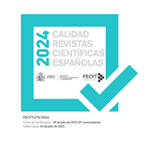Developing autonomy in English writing skills: a study on EFL learners’ selection criteria of open access and online self-correction tools
Resumen
This study aims to investigate, on the one hand, the use of blogs as a didactic resource for the acquisition of English written production skills and, on the other hand, the learners’ experiences and perceptions towards the use of open access and online self-correction tools that have been embedded as a repository of grammar checkers in an institutional blog. In order to shed light on these two issues, we have designed an online blog that hosts 11 open access and online tools that contribute to the learners’ self-awareness of the errors produced in English written texts. A survey was also embedded in the blog to examine the users’ satisfaction levels with regards to navigation, the display of video tutorials (for example, if they contribute to the development of English written skills), and whether the tools available in the blog were previously known by the users and were easy to use for the identification and self-correction of errors produced in English written texts. The results derived from this survey reveal that the respondents (n = 33) found that navigation of the blog functionalities was easy, and this is the case for the 11 tools available in the blog. Among them, the users considered five tools to be highly useful for the identification of grammar and lexical inconsistencies in their English written texts, namely, Hemingway, Language Tool, Reverso, Spell Check Plus and Virtual Writing Tutor.
Descargas
Descarga artículo
Licencia
La revista Círculo de Lingüística Aplicada a la Comunicación, para fomentar el intercambio global del conocimiento, facilita el acceso sin restricciones a sus contenidos desde el momento de su publicación en la presente edición electrónica, y por eso es una revista de acceso abierto. Los originales publicados en esta revista son propiedad de la Universidad Complutense de Madrid y es obligatorio citar su procedencia en cualquier reproducción total o parcial. Todos los contenidos se distribuyen bajo una licencia de uso y distribución Creative Commons Reconocimiento 4.0 (CC BY 4.0). Esta circunstancia ha de hacerse constar expresamente de esta forma cuando sea necesario. Puede consultar la versión informativa y el texto legal de la licencia.











